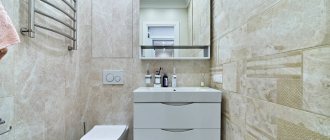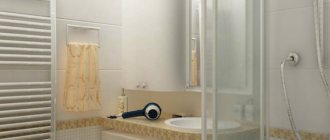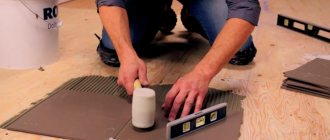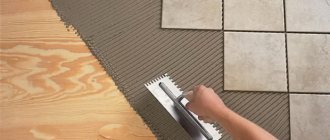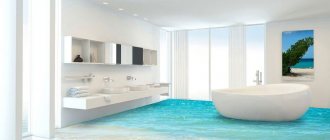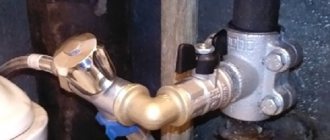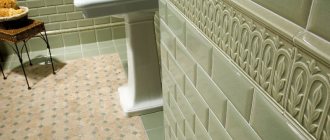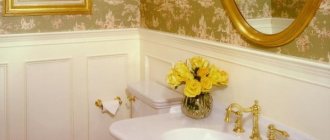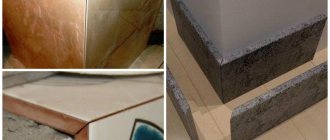Bathroom border – a finishing material used to cover the gap joint between the wall and the bathtub itself. Often called a “bathroom baseboard.” In addition to decorative functions, it serves a practical purpose - it prevents the penetration of moisture onto the floor.
Moisture under the bathtub can cause quite serious consequences:
- Cause the appearance of mold and mildew, the spores of which can harm human health - this is especially important for allergy sufferers and young children.
- In a humid environment, rot may occur, causing the release of substances with an unpleasant odor.
- Water may penetrate to the lower floors - then you will have to worry about repairs for yourself and the affected neighbors.
For a small room
If the bathroom is small, you want to choose a design that can at least visually expand its area.
It would seem that apartments in Khrushchev and small-family apartments have a completely hopeless design option for a small-sized bathroom.
Therefore, tiles in a bathroom in a Khrushchev-era building, as well as in a small family, should be selected taking into account certain rules.
So, it expands the volume of the room:
- small tiles and mosaics;
- light and cold shades;
- glossy surfaces;
- horizontal method of laying rectangular tiles on the walls;
- diagonal method of laying floor tiles;
- frieze or pattern along the walls.
Combining the horizontal method of laying tiles on the walls and diagonal on the floor
Advantages and disadvantages
Advantages of ceramic borders:
- High mechanical strength - resistant to deformation loads that occur when filling the bathtub with water and loads from a heavy person.
- They have a hard surface , so there are no scratches on it - you can use cleaning powders during cleaning work.
- Inert to most organic and inorganic substances - used with all types of detergents and cleaning substances.
- Waterproof product - absolutely not damaged by water.
- Wide temperature range of application from -60°C to 1000°C – can be used near heating devices, for example, near autoclaves or ovens.
- Good adhesion to most adhesives - tile adhesive, mastics, sealants, “liquid nails” and other types are used for their fastening.
- Long service life - over 25-50 years.
- Aesthetic properties - thanks to the various shapes and wide color palette, it can be used with a bathtub or tiles of different colors.
Flaws:
- Relatively high price - especially for borders with complex shapes, colors and sizes.
- Fragility is inherent in all ceramic products. Care is required during installation work and operation of installed curbs.
- Difficulty of installation - a person without the proper experience and knowledge will need several days to completely tile the perimeter of the bathroom.
Purpose of the ceramic border:
- Covering the joint between the bathtub and the tiles.
- Creating a tight connection to prevent water leakage outside the container.
- Formation of a single monolithic structure around the perimeter of the bath.
- Aesthetic design of the transition between tiles and bathtub.
"Basic" method
Scheme for laying tiles in the “basic” way
- This is the simplest and most common method in which the tiles are laid one above the other in simple rows parallel to the walls and corners.
The design resembles a checkered notebook sheet, and the seams between the tiles are straight lines. When laying wall tiles in this way, check the verticality of the lines with a plumb line, and the horizontality with a square.
This is the most economical installation method, which leaves a minimum amount of waste.
Types
Along with ceramic tiles, several types of borders from the same material are produced:
Pencil
The name comes from the size and shape of the product: a pencil is a narrow ceramic rod, several tens of centimeters in diameter. The outer side has a semicircular convex shape.
Products are produced with imitation of glass beads assembled into a single whole. They are used to create visually isolated zones on a surface made of tiles. Used for edging ceramic decors and mirrors. They have a wide range of colors, including imitation metal coatings, such as gold or silver.
Frieze
A flat product that has the thickness and length of the tile used, 2-9 cm wide. The border is used for design solutions for tiling tiles of different colors. The outer surface imitates tiles and is available in a wide range of colors. Produced with smooth and textured surface.
Angular
It has the shape of a concave or convex fillet. In addition, corner elements are produced; they are mounted in the corners of the room and provide a reliable joint between the mating borders. Some manufacturers produce borders with pre-cut ends at an angle; they are called right or left cut. At the ends, to close the voids, special end products are used - plugs. This border has a narrowly targeted application - masking the tile-bathtub joints.
The “running” or “bandaging” method
- also the simplest and fastest way. It has a benefit with uncalibrated tiles that differ in size, since it hides such a drawback.
The "take-off" method
Laying is carried out in horizontal rows. This arrangement of tiles in the bathroom is similar to brickwork: each row is shifted by ½ part of the tile relative to the previous one.
Note!
When using this method, you cannot take tiles of two colors or combine different textures: visually the floor will seem uneven.
Kinds
Tape
It is a polymer tape that folds along the long side. An adhesive tape is applied to the inside, similar to double-sided tape. During installation, it is necessary to use a hairdryer, which warms up the border to give it greater softness and elasticity. Without this operation, it is difficult to install a sufficiently rigid tape without gaps.
Plastic
Made in the form of a plastic triangular plinth with soft longitudinal edges - the name “dovetail” is found. Fastening is carried out using a sealant or glue with the general name “liquid nails”.
Ceramic
It is made from clay - the same one that is used to make tiles.
Advantages of the first two types:
- Affordable price;
- Convenience and ease of installation - anyone can handle it, without professional training.
- Absolutely resistant to moisture.
- Does not rot, is not destroyed by mold and mildew.
- The operating temperature range is +15°-50°C.
Flaws:
- The service life rarely exceeds 2-3 years.
- Smooth, flat surfaces are required, otherwise gaps will form that will have to be filled with sealant.
- Due to periodic exposure to water with variable temperatures, plastic loses its appearance - it becomes dull and turns yellow.
- Fastening with sealant or “liquid nails” is fragile and durable - this is especially true when using steel or acrylic bathtubs: when filling the bathtub with water and with a massive person, the structure deforms, which causes unacceptable loads on the adhesive joint.
"Diagonal" method
– the most complex and time-consuming.
Laying in a “diagonal” way
This method has a number of advantages:
- visually expands the area;
- if there are mistakes in the layout and the walls are not perpendicular or non-parallel, it hides this flaw;
- gives a beautiful and original drawing.
And also the disadvantages:
- Even minor deviations in the size of the tiles are not allowed;
- more waste.
With the “diagonal” method, the first row begins to be laid with cut tiles diagonally, which increases the percentage of waste.
The tile joints are located perpendicular to each other and at an angle of 45 degrees to the walls. Checking the accuracy of laying tiles in the bathroom is carried out with a level and a square.
The following options for laying tiles in the bathroom are a two-color combination of already known methods.
Properties of ceramic products
Ceramics are made from annealed clay.
Ceramic borders are coated on the outside with enamel, glaze - a thin glassy substance obtained from exposure to high temperature. Basic properties:
- It has a low water absorption coefficient, because is a water-repellent substance.
- Has high resistance to most chemical and organic solvents. Detergents and cleaners do not damage the surface and do not leave stains.
- Long service life - ceramic products last for centuries.
- The surface has high mechanical and wear-resistant strength. During operation, it is allowed to use hard abrasive cloths for cleaning.
- It is a non-flammable material.
- Ceramic products are dielectrics and are used in the electrical industry as insulators.
- They do not attract dust - they have antistatic properties.
Thanks to these properties, ceramic borders are widely used for finishing work in places where it is necessary to isolate the flow of water - in bathrooms; in kitchens - for insulating countertops and sinks.
"Modular" installation method
- an interesting and complex method that requires great care from the master. Tiles for the bathroom and toilet, laid in this way, give a dynamic, non-boring pattern.
"Modular" way
Features of the method:
- tiles are selected of one texture;
- a choice of contrasting colors is possible;
- the same elements laid out in a different order will give a completely different pattern;
- at least three standard sizes of tiles are used, and all sides of such a tile are multiples of each other;
- preference is given to special tiles marked “modulare”, adjusted in strict accordance with all sizes.
Prices
The price for curbs is determined by:
- Manufacturer's selling price.
- Trade markup of the wholesale and retail network.
- Depends on the region, transport distance from the manufacturer.
For example, a border with the name “White Corner M200” costs:
- Chelyabinsk, 27-45 rubles per piece;
- Novosibirsk, 33-43 rubles/piece;
- Samara, 31-45 rubles/piece;
- Moscow, 25-55 rubles/piece;
Choosing PVC panels for the bathroom
When arranging bathrooms and showers, plastic PVC panels are becoming increasingly popular. Firstly, they are inexpensive, and secondly, they give the room an aesthetic appearance. PVC panels for the bathroom differ from plastic panels for the ceiling in durability. After all, during operation they are touched with hands, washed, and may even receive accidental blows.
Advantages of PVC panels for the bathroom
- Ease of installation. No extensive wall preparation is required, such as removing paint. It is enough to install the guides and the base according to the level.
- 100% moisture resistance indicators. PVC panels for the bathroom have excellent waterproofing properties.
- They have good heat and sound insulation properties.
- Ease of maintenance. Doesn't require much effort.
- Huge selection of panels. Today you can find textured, smooth, glossy, matte PVC panels.
- Efficiency of installation of PVC wall panels. If the bathroom area is 5-10 square meters, then you can install the panels within just one day.
- Budget cost. Unlike ceramic tiles, marble and other building materials, plastic is much cheaper.
Practical tips for choosing PVC panels for the bathroom
- Choose light-colored panels, especially if the room is small. This allows you to visually increase the living space.
- Use panels that imitate natural materials, such as maple, cedar, pine.
- The stiffening ribs of the panels must not be damaged or deformed. This may be due to poor quality transportation or storage.
Features of installation of PVC panels for the bathroom
- Under no circumstances should stiffening ribs protrude on the front surface.
- Installation should be performed at warm room temperature, preferably above zero.
- For better thermal and waterproofing, the joints must be lubricated with sealant. Therefore, in addition to a screwdriver and self-tapping screws, purchase sealant.
- It is best to finish the bath after the ceiling and floor have been installed.
You can buy PVC panels for the bathroom from our company. Firstly, we have the most reasonable prices for PVC products. Secondly, we employ experienced managers who are always ready to quickly make calculations and provide free advice in the field of building finishing materials.
Source: panel-52.ru
How to install PVC panels with frieze
Plastic panels for a bathroom with a frieze are mounted in the same way as other types of this finish - either using lathing or by gluing directly to the wall.
In order to glue the strips to the wall, you need to:
- perfectly align the walls;
- ensure that the surface is dry and clean;
- apply glue to the panels;
- press them against the wall and hold for a few minutes.
Installation using lathing is carried out as follows:
- A sheathing made of wood or metal profile is attached to the walls.
- The panels are cut to the required length.
- The strips are attached to the sheathing using screws or nails.
- The finishing elements (plinths, corners) are being installed.
When installing, you need to consider several important points:
- PVC panels for a bathroom with a frieze should be installed only in a vertical position, otherwise the design will lose its attractiveness.
- For the lathing, you should choose a metal profile, since wood is afraid of moisture.
- It is better to cut such finishing material with a hacksaw.
Decorating walls with PVC panels with a frieze will successfully replace tiles in a bathroom or toilet and will serve you well for many years.
How to properly glue a bathroom corner, what glue is best to use
Most DIYers install bathtub baseboards using silicone sealant. Very often, the seam darkens due to the fact that mold begins to develop in it. If such a situation occurs, it is recommended to completely dismantle the product, disinfect and degrease the surface, and then reinstall it.
Depending on the quality and composition of the sealant, the period before mold appears is from 6 months to three years. Additionally, this is influenced by the quality of ventilation and the intensity of use of the bathroom. To prevent such a development of the situation, there are several ways out. For example, before gluing the border to the bathtub, you need to apply a special sealant intended for aquariums. Due to the presence of antibacterial components in the composition, this adhesive composition “does not bloom.”
Aquarium sealant can be transparent or white, is mainly sold in small jars and has a high price. But the long service life eliminates this disadvantage.
In most cases, bathtub baseboards are installed using silicone sealant
Another option is waterproof glue, which is a little more expensive than regular glue, but much more reliable. If you use the glue strictly according to the instructions, it will last a long time, and fungi and mold will not multiply and spoil the appearance of the bathroom.
Important advice! If the border is attached to the surface of an acrylic bathtub, then before applying the sealant it is imperative to fill the bowl with water as much as possible and leave it in this form until the adhesive composition has completely hardened. Otherwise, during operation, the sealant will move away, which is why a gap will form.
A good, high-quality, but expensive sealant is considered to be based on MS polymers that have a hydrophobic effect. This allows the product to repel water even a year after application, while conventional acrylic glue flows after only 4-6 months.
Among polymer sealants you can also find options with antibacterial components in the composition that prevent the appearance of fungi. Another advantage is considered to be high elasticity, even after drying, which allows the adhesive mixture to maintain its original position when heavy cast iron or metal baths move.
The border should be glued to the plane of the wall, while the lower part should be pressed as tightly as possible against the surface of the bathtub
Why the baseboard can come off and how to avoid the problem
Many users, after installing a tile border, note that after a short time the tape partially or completely peels off. This happens due to constant vibrations and small movements of bathtubs or showers that occur when filling water and when a person is inside.
No matter how carefully you use the bathtub, there will still be minimal movement of the plumbing. This is especially noticeable in the presence of lightweight acrylic bathtubs and showers, from which the curb usually falls off faster than from steel or cast iron bowls.
To avoid such a problem, you need to know how to glue the border in the bathroom correctly. If we are talking about a PVC product, then the plinth should be glued only to the plane of the wall. In this case, it will be possible to avoid leaks into the gap between the bathtub and the wall. The lower part of the side should be pressed as tightly as possible to the surface of the bath to minimize the ingress of water.
To avoid the problem of unpleasant odor coming from under the side, it is recommended to fill the gap with sealant before installing it.
With this installation option, movements of the plumbing fixtures will be compensated due to the elasticity of the curb, and the product itself will adhere tightly to the wall surface. Another reliable option is the same sealant based on MS polymers, which is more suitable for metal bathtubs than for acrylic ones.
Another common problem when using PVC skirting boards is the appearance of an unpleasant odor from under the plastic. The cause of this problem is the microscopic cracks left after installation, where a small amount of moisture penetrates. A damp and dark area is an ideal environment for pathogens to multiply. This is why it is highly recommended to fill the gap with sealant before installing any baseboard, even if the curb manufacturer does not suggest this action.
How to properly attach a tiled border to a bathtub
The edge made of ceramic tiles consists of straight, end and corner elements. The required number of straight parts depends on the parameters of the bathtub bowl or tray. Experts recommend taking one more straight piece so that there is at least a minimum margin for trimming. With a traditional bathtub installation, you will need 2 corners and ends each. If we are talking about a standard rectangular shower, it will be enough to take one element each.
Installation of a tiled border on a bathtub should start from the corner
Before purchasing, it is recommended to carefully check all components not only for damage, but also for perfect joining of the elements with each other. If there is minimal discrepancy, it is permissible to trim the edge a little using a file. The method of installing the tiled edge depends on the type of wall cladding and the size of the gap:
- If it is a glossy smooth tile, it is enough to use waterproof glue for fastening.
- When textured tiles or rough plaster are laid on the walls, it is better to use a special adhesive for ceramic tiles for installation, intended for application in rooms with high humidity. This adhesive composition is sold dry, and to prepare it you just need to add a little water.
- If there is a significant gap, it is better to seal it first and lay the tiles on a slope, especially if a shelf larger than 5 cm is formed.
- In any case, installation should begin from the corner, covering two adjacent areas in parallel.
Each bathtub curb has its own advantages and disadvantages. When choosing a product, you must take into account that the baseboard must be waterproof, practical and ideally combined with the surrounding surfaces. When purchasing, you also need to make sure that the product fits the width, completely covers the gap, and has at least a small margin. If you follow all installation rules and choose high-quality glue, you will not have to deal with leaks.
Stripes
| Another easy way to decorate a plain wall is by using tiles of a different color or texture. Darker stripes laid out with the same tiles as the floor look good against a neutral light background. |
Features of PVC panels with frieze
Panels made of polyvinyl chloride are produced by foaming this material. Thanks to this method, the products are light, but at the same time durable. Modern technologies make it possible to apply absolutely any design to the surface. Such material can imitate wood, tile, artificial stone.
There are PVC panels with a frieze that completely imitate tiles. You can even make a drawing that is exactly what you need. Due to the fact that the design is coated on top with waterproof varnish, it does not wash off and does not lose its qualities for many years. With proper care, this coating can last up to 10 years.
The sizes of the strips are large, which allows you to complete the finishing in the shortest possible time. This type of siding has a number of advantages over other finishing materials. They are as follows:
- durability;
- resistance to temperature changes and high humidity;
- good sound and heat insulation;
- ease of installation work;
- low cost;
- variety of textures and colors;
- ease of care;
- harmless to the human body.
As for the shortcomings, there are not many of them. PVC panels with frieze do not withstand strong impacts and release toxic substances when burned.
As you can see, the advantages of this wall decoration far outweigh its disadvantages, which is why many people choose this option when renovating.
Chaotic layout
| This is a great way to use up leftover tiles! And any error in the layout can be explained with the words “it was intended that way.” But seriously, this type of installation is good because it allows you to create a truly unique interior. Especially when the master does not have to follow the order of alternation of individual elements. |
Installation
Consists of several stages:
- Calculation of the number of borders.
- Preparatory work.
- Installation.
Calculation of the number of ceramic borders
- The perimeter requiring closure is determined.
- The result obtained is divided by a size equal to the length of the border. Note: In this case, the same units of measurement must be observed.
- Calculated data are rounded up.
Advice: it is advisable to take 1-3 additional curbs in case they are damaged during installation work.
Preparatory work
- Assembling the tool:
- ruler, tape measure;
- rubber or plastic spatula;
- rubber protective gloves;
- mounting gun for sealant or glue “liquid nails”;
- grinder with diamond wheel;
- emery block or cloth;
- sanitary sealant, liquid nails glue, mastic or dry glue for gluing tiles in a volume of 1-1.5 kg;
- The surface in the work area is cleaned of dirt and tile adhesive residues.
- The surface is degreased.
- If necessary, markings are made for the location of the curb.
Adviсe:
- The spatula should be made of a non-marking material, such as white rubber or silicone. Blade width 20-40mm.
- One adhesive composition is selected - the most durable and reliable connection is provided by mastic for gluing tiles.
- If you use sealant or liquid nails, you need to make sure that they are sanitary, that is, they are not susceptible to mold or blackening from fungus.
- Ordinary vodka can be used as a degreaser.
Installing a ceramic border under the tiles
Option 1 – one border is installed, without preliminary laying of tiles:
- Marking is carried out for the location of the curb;
- The location of the trimmed border is selected - in the case of a multiple ratio of the size of the bathroom with the dimensions of the border itself, this can be near the left or right corner.
- Installation begins from the corner, the adhesive is applied to the curb, which is installed in place with little effort.
- Excess glue that appears is immediately removed with a slightly moistened rag; if this procedure is left “for later,” it will be very difficult to remove the frozen glue, and the mastic will be almost impossible.
- Upon completion of the installation of the entire row, the seams are sealed - excess glue is immediately removed from the surface of the border or tile.
- End caps are installed with glue. The tiles are installed on top of the curb.
Option 2 – the border is mounted with tiled floors:
- The bathtub is lowered on legs or moved to the side.
- The border is placed under the tile - markings are made, including the location of the lower part.
- A temporary support is installed, for example, a wooden or plastic strip - necessary to prevent the curb from sliding under its own weight.
- The operations according to the previous option are repeated.
- After the adhesive has set, which usually occurs after 24 hours, the temporary support is removed.
- The bathtub is moved as close as possible to the wall, but no more than 15-20 cm.
- The location of the upper cut of the bathtub and the lower cut of the curb is monitored - a gap of at least 5 mm is required.
- Glue is applied to the bottom of the border row.
- The bathtub moves close to the wall.
- The bathtub rises upward using height-adjustable legs.
Option 3: the bathtub is installed in place, the tiles are laid.
Explanation. It is assumed that before laying the tiles, a place was marked for the future installation of the border.
If errors were made during marking, then the following actions must be performed:
- Option 2 can save the situation - the presence of adjustable legs.
- Using a border of a different size.
- Sawing the bottom of the tile using a grinder.
In terms of the sequence of operations, this option is no different from the first.
Installing a ceramic border on tiles
In terms of complexity, this operation is somewhat easier than the previous ones and is similar in execution to option 1. The difference is that the curb is installed directly on the tile and bathtub at once.
Source: housetronic.ru
Ornament
| A type of decor when fragments smaller in size than the main tile form a pattern or a repeating motif. Looks especially advantageous in combination with plain stripes. |
How to choose frieze panels
In order for the renovated room to please you with its appearance for many years, it is important to choose the right material.
For a bathroom and toilet, for example, you should choose a finish with a smooth surface. After all, high humidity in such rooms promotes the growth of fungus, which can accumulate in relief elements. As for the color scheme, plastic panels with a frieze or with photo printing are suitable for such rooms. Products with a pattern are suitable for a kitchen apron.
For other rooms, such as an entrance hall or loggia, you can choose wood finishes. It will look organic in these rooms.
When purchasing, pay attention to several important points:
- the coating of the strips must be smooth, without defects;
- be sure to check the batch, otherwise the products may differ in color;
- The stiffening ribs inside the panel should be at a distance of 5-10 cm, otherwise such a product will be fragile;
- The edges of the strips must be perfectly smooth, because defects will be visible during installation.
By choosing plastic panels with a frieze, you can zone the bathroom. Pay attention to the PVC panels with the “Lion” frieze. This is the most popular tile series. Imitation of marble chips will create a unique style. Among the variety of colors, you will definitely choose the one that suits your bathroom.
Another interesting solution is a PVC panel with an “Aquatone” frieze. A 3D drawing is applied to it using special technology. This finishing will make your renovation exclusive. There are also models with sparkles that will give the room a solemn look.
